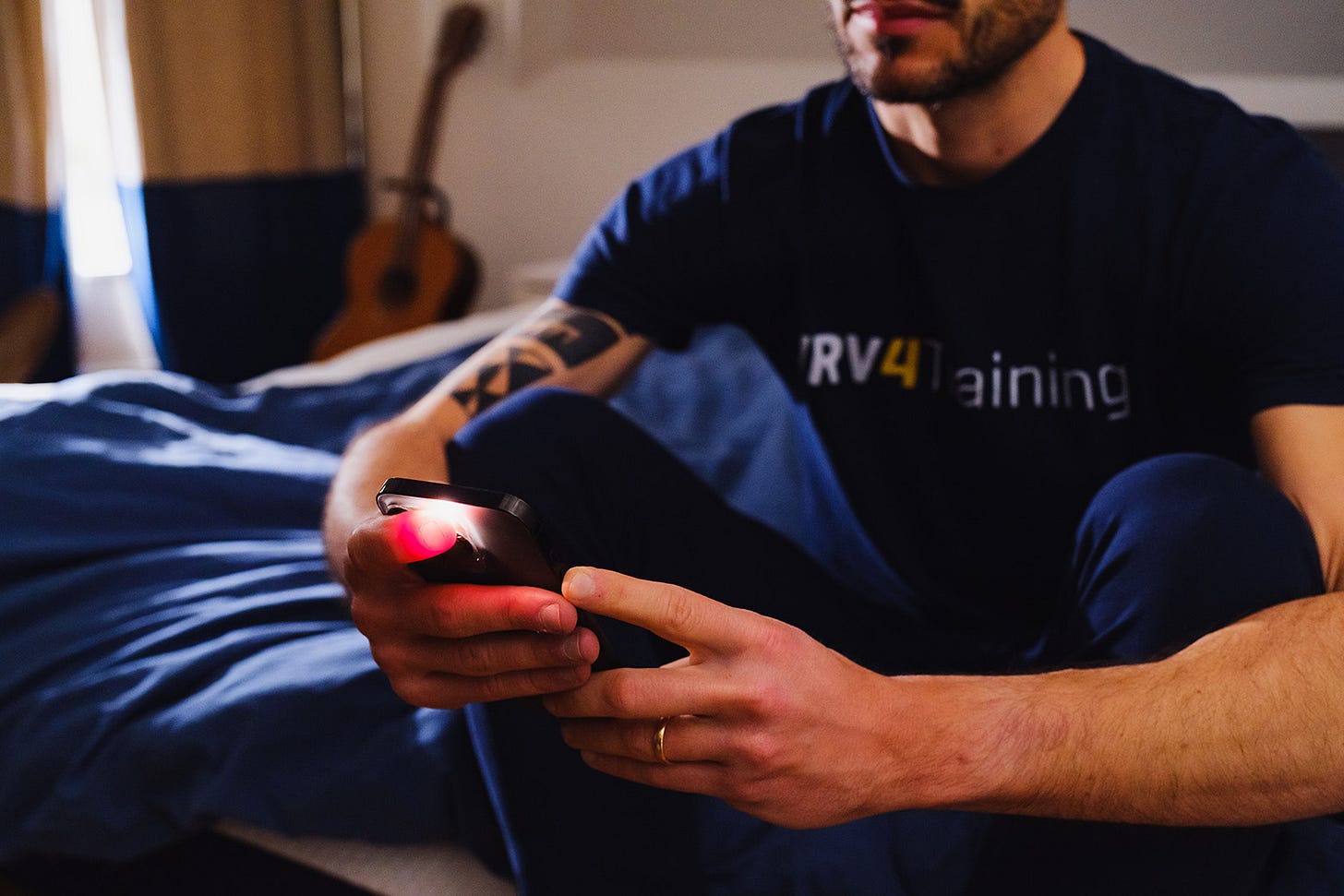How Should You Measure Your Morning Heart Rate Variability? (HRV)
Guidelines and practical tips

Morning measurements of resting physiology (heart rate, heart rate variability), are arguably the most practical and effective way to capture our acute response to daily stressors as well as long-term or chronic changes in baseline physiology.
In this blog, I cover simple guidelines and try to clear up some confusion when it comes to taking such morning measurements so that you can ensure your data is high quality and representative of what you are trying to capture: your body’s response to major stressors (as opposed to the transitory stressors that happen continuously during the day, or changes in physiology due to sleep stages and the circadian rhythm during the night).
TL;DR
Our Recommended Protocol:
🕒 When?
Right after waking up, before breakfast, caffeine, or any significant movement — but after going to the bathroom if that’s part of your usual routine.
🪑 In which body position?
Seated, with your back straight but relaxed, feet flat on the ground. For well-trained individuals, this position provides more useful and sensitive data compared to lying down.
⏱️ For how long?
A 1-minute recording is enough to capture a reliable measurement.
📱 With what?
Using the HRV4Training app, either with your smartphone’s camera (PPG technology) or with a chest strap like the Polar H10 (ECG-based).
Keep reading for all the details.
When should you measure?
Ideally, you want to measure right after waking up. This means in the first 5–10 minutes, before other stressors (no coffee, no exercise, no reading your email or social media).

If you need to go to the bathroom before measuring or to change room, that is totally fine (emptying the bladder is typically part of research protocols in studies where HRV is measured in the morning).
If you prefer not to measure in your bedroom (you don’t keep your phone there, or you have pets or young children or any other reason), it is no problem to go to another room and lie down or sit there (more on body position later). Make sure to measure following a similar routine on most days.
If you work in team settings, and measuring in the morning is not feasible, you might be able to collect decent data in the first 2 hours after waking up. A recent study using HRV4Training in the morning or 2 hours later at the facilities, showed a high correlation among female rowers.
However, typically, the earlier the better. If you measure later, make sure also to avoid any fluid intake, as this could impact acutely your measurement, causing an increase in parasympathetic activity (reduced heart rate, increased HRV), for more than thirty minutes.
Whenever possible, measure in the first 10 minutes after waking up and going to the bathroom.
How should you breathe?
Breathing impacts HRV. In particular, deep breathing (e.g. 5–6 breaths/minute) increases acutely HRV (this is the whole point of HRV biofeedback, something I discuss here).
When we measure in the morning, we are not interested in artificially increasing HRV, or in training our parasympathetic system (something theoretically we might be doing when deep breathing).
Remember our application of interest: your body’s response to major stressors, or what we call baseline physiological stress.
To capture baseline physiological stress, you want to measure while breathing freely, self-paced. It is fine if your breathing is slower or deeper than your regular free-living breathing rate. The only thing to avoid is to take intentionally very deep breaths. While some tools offer breathing pacers, we have seen no improvement in measurement reliability when doing so.
If you measure your HRV in the morning using the Breathe app in the Apple Watch, we recommend disabling the breathing pacing (which typically vibrates to guide you in a deep breathing exercise).
Relax and breathe naturally.
Should you lie down, sit or stand?
Personally, I have changed my mind after several conversations with a trusted expert in the field (Andrew Flatt), self-experimentation in different positions over an entire year (so that I could look at the relationship between the data and various acute and chronic stressors) as well as reading the available literature (which I have summarized here). I now consider sitting the best and most effective way to capture data, especially for athletes.
First thing first: what’s the difference between positions? As Andrew explains, when lying down, HRV represents cardiac autonomic nervous system activity during undisturbed rest. On the other hand, sitting or standing HRV represents cardiac autonomic nervous system activity in response to physiological stress (orthostasis) with a strong influence from the baroreflex. The physiological challenge exacerbates your response so that if something is off (there is more stress, sickness, or anything else), there will be a much larger change in HRV (and resting heart rate) with respect to the change you would see if you are lying down (sleeping or in the morning).
Thus, an orthostatic stressor, which here means measuring while sitting or standing, makes it so that HRV becomes more sensitive to the stressors you are facing, and therefore more useful. For more details on these mechanisms, please check out Andrew’s great blog here.
Measuring while sitting or standing can be particularly beneficial if your heart rate is low, e.g. low 50s or lower, since parasympathetic activity is already high. Measuring while sitting or standing, you might also be less prone to another rare issue of measurements taken lying down, parasympathetic saturation (a situation in which your HRV measurement does not reflect parasympathetic activity, basically your HRV would be suppressed despite actual parasympathetic activity being elevated). This is particularly true if your training volume is high.
Personally, I measure while sitting. My main motivation for recommending sitting as opposed to standing to most people is only practical: typically it is easier to mess up a measurement when standing, as people tend to be impatient. Similarly, it might be easier not to move while sitting.
Finally, in many cases, data collected while lying down will be very similar to data collected while sitting, in terms of relative changes over time, and therefore if you have been lying down and seeing the impact of different stressors on your resting physiology, that is perfectly fine and there is no need to change. However, if you see only minor changes in your data, or you see suppressed HRV despite low HR and feeling good (possible parasympathetic saturation), then it might be a good idea to measure while sitting.
Below is an example showing acute sickness, and how the orthostatic stressor (i.e. sitting in the morning for a measurement) captured very well the acute phase, possibly with an early warning, as well as the recovery phase, while night data, collected while lying down, failed to capture any actionable information apart from the acute phase (one day).
While here is another case study where I show how sitting provides more useful data with respect to what we can collect during the night, while asleep.
Remember that body position needs to be consistent for the data to be interpreted correctly, so use the same body position every day. If you decide to change, give it a few weeks so that HRV4Training can learn your new normal physiological state, and correctly interpret deviations from your normal.
Measuring while sitting (or standing) is preferable for a more sensitive measure of your response to different stressors.
For how long should you measure?
Measurement time depends on what HRV features we are interested in. To assess baseline resting physiology, most tools today rely on rMSSD or a transformation of rMSSD (HRV4Training, Oura, and Whoop report rMSSD, while for example Apple reports features that are less effective for this purpose, such as SDNN).
This is good news as rMSSD is time-invariant, and is reliable even when measurements are as short as 1 minute (or a little less). If you prefer to measure for longer, you might get slightly more stability. Given that rMSSD is time-invariant, you can also change your measurement duration over time without the need to re-acquire a baseline. Values are directly comparable (this is not the case for most other HRV features, or when changing body position).
1 minute is sufficient, and would not measure for more than 2 minutes with optical sensors
What about artifacts?
Your software of choice needs to deal with artifacts. Artifacts could be due to actual cardiac abnormalities (ectopic beats or other), or hardware and software issues (optical methods are particularly prone to noise when there is any level of motion, while chest straps might suffer from poor skin contact, etc.).
How your software deals with artifacts might be outside of your control, but it should be something to check with your software provider. Poor artifact handling can make an ECG system (theoretically the gold standard) less accurate than using a phone camera, as shown in this validation of different HRV systems, where HRV4Training using the phone camera outperformed, among others, Firstbeat’s ECG system.
On top of the above, there are additional issues we might be introducing when measuring. For example, yawning or swallowing impact cardiac activity acutely. While heart rhythm will come back to normal in a matter of seconds, if this happens during a measurement, we are introducing more artifacts.
Make sure to use a system that is robust against artifacts and try to avoid movement, yawning or swallowing during your measurement.
Wrap up
I hope this blog clears up some doubts when it comes to how to take your morning measurements.
Normally, it’s really simple: when you wake up, grab your phone, take your one-minute measurement, and you are good to go.
take it easy!
Endurance Coaching
If you are interested in working with me, please learn more here, and fill in the athlete intake form, here.
How to Show Your Support
No paywalls here. All my content is and will remain free.
As a HRV4Training user, the best way to help is to sign up for HRV4Training Pro.
Thank you for supporting my work.
Marco holds a PhD cum laude in applied machine learning, a M.Sc. cum laude in computer science engineering, and a M.Sc. cum laude in human movement sciences and high-performance coaching. He is an Endurance Coach at Destination Unknown.
He has published more than 50 papers and patents at the intersection between physiology, health, technology, and human performance.
He is co-founder of HRV4Training, advisor at Oura, guest lecturer at VU Amsterdam, and editor for IEEE Pervasive Computing Magazine.
Social:








Thanks for the guidance Marco! At the moment I’m focusing on recovering from post viral fatigue / long COVID. When I wake up in the morning, often I’ll meditate or do a guided yoga nidra script in bed before I get up for the day. Sometimes I fall asleep again. Would you be measuring post yoga nidra? Or before?
Oh thank goodness for this guidance, after bathroom and seated is just so much less disruptive than trying to take the “just after waking, before getting out of bed” guidance literally. 😄 I also think the case you make for a seated measurement being more useful is quite compelling. I will be curious to see how much my measurements differ.